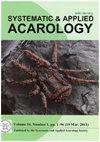Mites associated with Vitis labrusca (Vitaceae) in southern Brazil: Population dynamics and ecology
IF 1.2
3区 农林科学
Q2 ENTOMOLOGY
引用次数: 0
Abstract
Abstract Viticulture is one of the main economic activities in Rio Grande do Sul (RS), Brazil, with emphasis on the American grape varieties, Vitis labrusca L. (Vitaceae), used in producing juices and wines. The present work aimed to identify the mite species associated with American grapevines (V. labrusca), their possible natural enemies, and their population fluctuations. The selected varieties were: Bordô (Bd) and Couderc (Cc and Cd) in Dois Lajeados (RS), Bordô (Bi) in Imigrante (RS) and Bordô (Bp), in Putinga (RS). The study was conducted monthly between March 2017 and March 2018, evaluating 20 randomly selected plants from each municipality. We found 5,452 mites belonging to 13 families, distributed across 29 genera and 42 species, or belonging to the suborder Oribatida. Higher mite richness was observed on Cc (12 species) and higher abundance on Cd (2,812 specimens), Cc (868) and Bi (799). Among the predatory mite families, Stigmaeidae had the highest abundance (896 specimens), followed by Phytoseiidae (746). The most abundant species observed were Euseius mesembrinus (Dean), Agistemus riograndensis Johann & Ferla, Tydeus californicus (Banks), Polyphagotarsonemus latus (Banks) and Tarsonemus sp. This is the first study in southern Brazil that evaluates and reports the mite fauna and its ecology on American grape varieties, with high abundance and frequency of predatory mites. This work is important to assist in implementing management techniques that promote the maintenance of predatory mite species in these vineyards.巴西南部与葡萄科(Vitis labrusca)相关的Mites:种群动态和生态学
葡萄栽培是巴西南大州(RS)的主要经济活动之一,主要种植用于生产果汁和葡萄酒的美国葡萄品种Vitis labrusca L. (Vitaceae)。本研究旨在鉴定美洲葡萄螨的种类、可能的天敌及其种群消长。所选品种分别为:杜伊斯拉杰多斯(RS)的Bordô (Bd)和Couderc (Cc和Cd),移民(RS)的Bordô (Bi)和普廷加(RS)的Bordô (Bp)。该研究于2017年3月至2018年3月期间每月进行一次,评估了每个城市随机选择的20种植物。共发现螨类5452只,隶属于甲螨亚目29属42种,隶属于13科。螨在Cc(12种)、Cd(2812种)、Cc(868种)和Bi(799种)上的丰度较高。捕食性螨科中以刺螨科(896份)丰度最高,其次为植螨科(746份)。观察到的最丰富的物种为间膜雌蚊(Euseius mesembrinus, Dean)、riograndensis Agistemus Johann & Ferla、加州Tydeus (Banks)、polyhagotarsonemus latus (Banks)和Tarsonemus sp.。这是巴西南部首次对美洲葡萄品种螨群及其生态学进行评估和报道的研究,发现捕食性螨的丰度和频率都很高。这项工作是重要的,以协助实施管理技术,促进这些葡萄园的掠食性螨种的维护。
本文章由计算机程序翻译,如有差异,请以英文原文为准。
求助全文
约1分钟内获得全文
求助全文
来源期刊

Systematic and Applied Acarology
ENTOMOLOGY-
CiteScore
2.20
自引率
33.30%
发文量
152
期刊介绍:
Systematic and Applied Acarology (SAA) is an international journal of the Systematic and Applied Acarology Society (SAAS). The journal is intended as a publication outlet for all acarologists in the world.
There is no page charge for publishing in SAA. If the authors have funds to publish, they can pay US$20 per page to enable their papers published for open access.
SAA publishes papers reporting results of original research on any aspects of mites and ticks. Due to the recent increase in submissions, SAA editors will be more selective in manuscript evaluation: (1) encouraging more high quality non-taxonomic papers to address the balance between taxonomic and non-taxonomic papers, and (2) discouraging single species description (see new special issues for single new species description) while giving priority to high quality systematic papers on comparative treatments and revisions of multiple taxa. In addition to review papers and research articles (over 4 printed pages), we welcome short correspondence (up to 4 printed pages) for condensed version of short papers, comments on other papers, data papers (with one table or figure) and short reviews or opinion pieces. The correspondence format will save space by omitting the abstract, key words, and major headings such as Introduction.
 求助内容:
求助内容: 应助结果提醒方式:
应助结果提醒方式:


